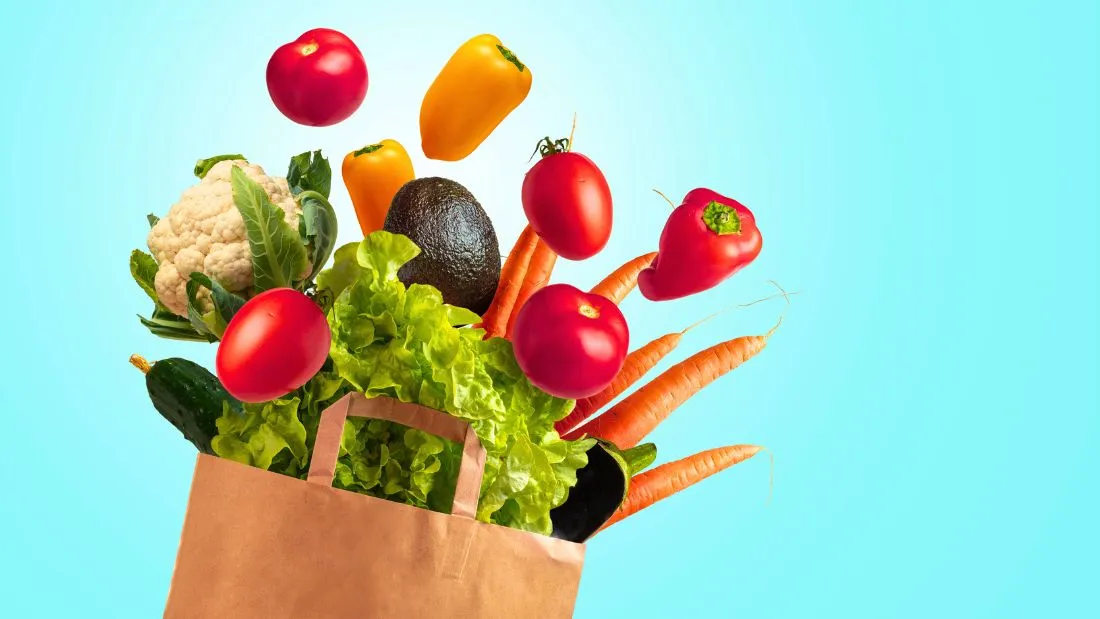Tomatoes and peppers – battle of the nutrients

Tomatoes and peppers contain over 90 per cent water but both still manage to pack a good amount of important nutrients, each offering its own unique selection of vitamins, minerals and disease-busting antioxidants.
Low in fat and calories, tomatoes and red peppers are a great option if you’re watching your weight. A medium-sized (123-gram) tomato contains just 22 calories while a medium (119-gram) red pepper contains around 30 calories – a little higher because of its natural sweetness. Although they have more sugar, peppers also contain almost double the fibre of tomatoes; 2.5 grams compared to 1.5. This makes a modest contribution towards the 30 grams a day of fibre recommended to keep your digestive system healthy and lower the risk of heart and circulatory diseases, type 2 diabetes and some cancers.
Both tomatoes and peppers provide an excellent source of vitamin C, essential for immune function and maintaining healthy skin, blood vessels, bones and cartilage. One medium tomato provides over 40 per cent of the recommended daily amount of vitamin C but a medium-sized red pepper provides a whopping 380 per cent of your daily needs, making red peppers one of the richest dietary sources of this essential nutrient.
Vitamin A is important for your immune system, eye health and vision and your body converts the pigment beta-carotene, found in red, orange and yellow fruit and vegetables, into vitamin A. Carrots are a very rich source of beta-carotene, hence the name, but ripe and tinned tomatoes and red peppers provide moderate amounts too. Remember, red peppers are much richer in beta-carotene and vitamin C than green ones.
Vitamin E helps maintain healthy skin and eyes and also strengthens your immune system, supporting your natural defences against illness and infection. It’s an important antioxidant that protects your cell membranes from damage. Again, both tomatoes and peppers are good sources, with a medium tomato providing around a fifth of your daily needs and a medium red pepper, around half.
While green leafy vegetables, such as spinach, kale and broccoli, provide the best sources of vitamin K, needed for healthy blood clotting, tomatoes and peppers contribute moderate amounts but in this instance, green peppers contain more than red.
Peppers and tomatoes also contain small amounts of magnesium, potassium, calcium and iron so when eaten regularly, as part of a varied vegan diet, they can contribute to your overall intake of these important minerals.
Antioxidants
In addition to all this, tomatoes and peppers excel in their high content of antioxidants – a collection of many different compounds that combat the action of destructive molecules called free radicals linked to cancer and other chronic diseases. Antioxidants can disarm free radicals before they do any damage and there are hundreds, probably thousands, of different substances that act as antioxidants in food – especially plant foods. They are undoubtedly one of the reasons why vegans have a lower risk of cancer and other diseases compared to meat-eaters. The best-known are the ACE vitamins – A (beta carotene), C and E, plus selenium, lycopene and polyphenols, but there are many, many more.
Tomatoes are a very rich source of the antioxidant lycopene (peppers contain none). This red pigment has been linked to many health benefits, including reducing the risk of heart disease and cancer. Thanks to their high lycopene content and other powerful antioxidants, tomatoes and tomato products may also help protect your skin from sun damage. Tomatoes should not be used to replace sunblock but they may help increase your skin’s defence against sunburn and damage caused by UV rays.
The redder the tomato, the more lycopene it contains and the peel contains most of all. Tomato products, such as tomato juice, tomato purée and tomato-based sauces, actually contain more lycopene than fresh tomatoes because they are more concentrated. Cooking also increases the lycopene content and if you have some healthy fats along with your tomatoes, it’ll help your body absorb even more lycopene. Interestingly, organic ketchup may contain up to five times as much lycopene as non-organic. Scientists say the best rule of thumb is to pick the darkest red ketchup.
Peppers are also called sweet or bell peppers and can be eaten raw or cooked. Like chilli peppers, they can be dried and ground to a powder called paprika. They come in various colours, including red, yellow, orange and green — which are unripe and not as sweet as red ones. Red peppers are especially high in capsanthin, a powerful antioxidant responsible for their brilliant red colour. Yellow, orange and green varieties contain higher levels of other antioxidants such as violaxanthin, lutein, quercetin and luteolin. These plant compounds are associated with many health benefits such as improved eye health and reduced risk of chronic diseases.
Nightshade but not Deadly
Tomatoes and peppers belong in the nightshade family, along with aubergines and potatoes. Most people can digest them without any problem but there are a few potential issues for people with specific health conditions. Nightshades may not agree with people with inflammatory gut conditions, such as IBS or leaky gut syndrome and arthritis can sometimes also be aggravated by nightshade plants.
For most people, tomatoes and peppers are a nutritious choice that can be included in a healthy, varied, vegan diet. They complement each other well in terms of flavour, texture and nutritional content, making them great additions to salads, pizzas, pasta dishes, curries, tagines, ratatouille, sauces or a simple red pepper and tomato soup.
If possible, choose locally grown tomatoes and peppers – not just to protect the environment but because they tend to taste better, too. If you have a garden, try growing your own in a pot – you really can’t beat the taste!




